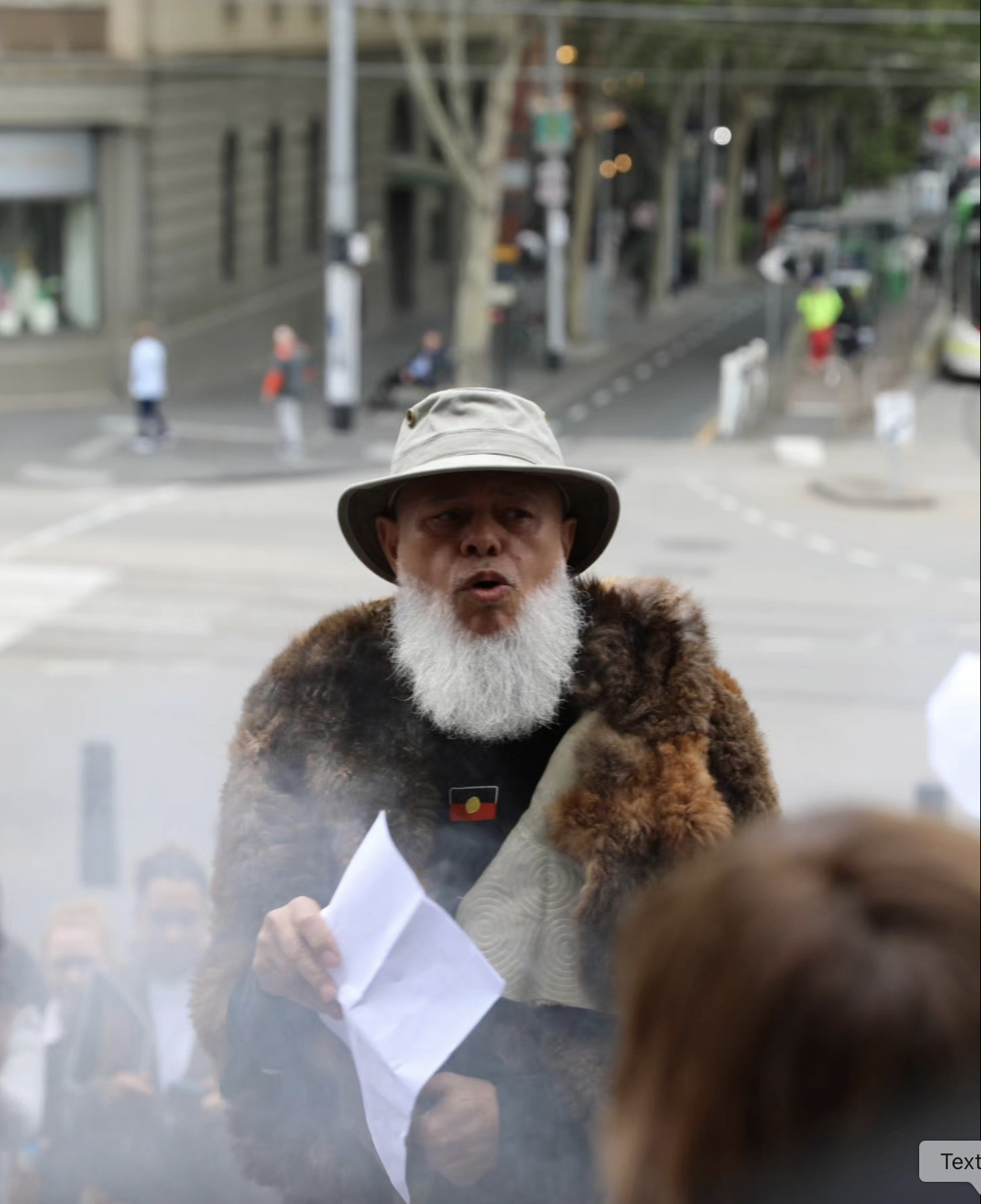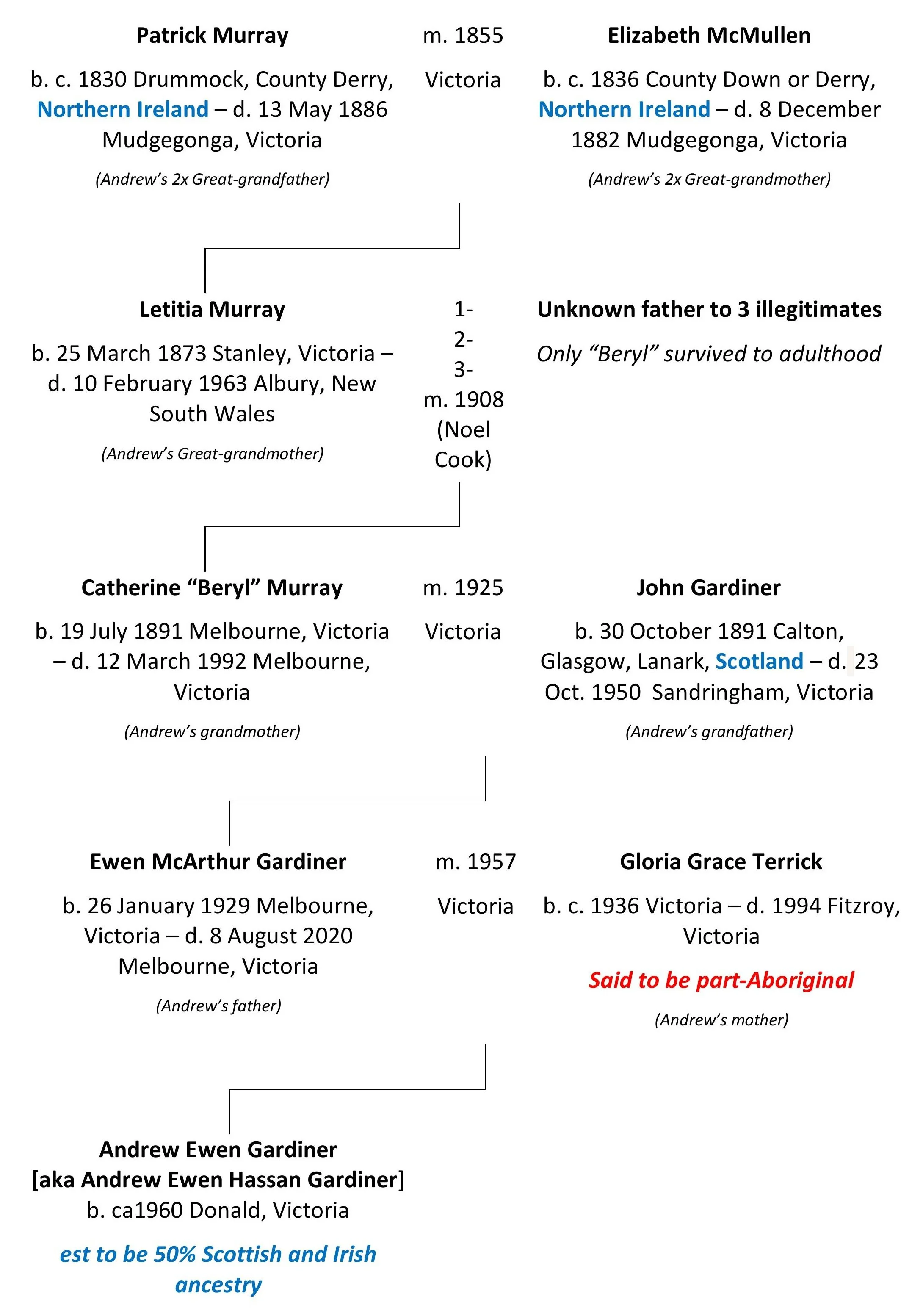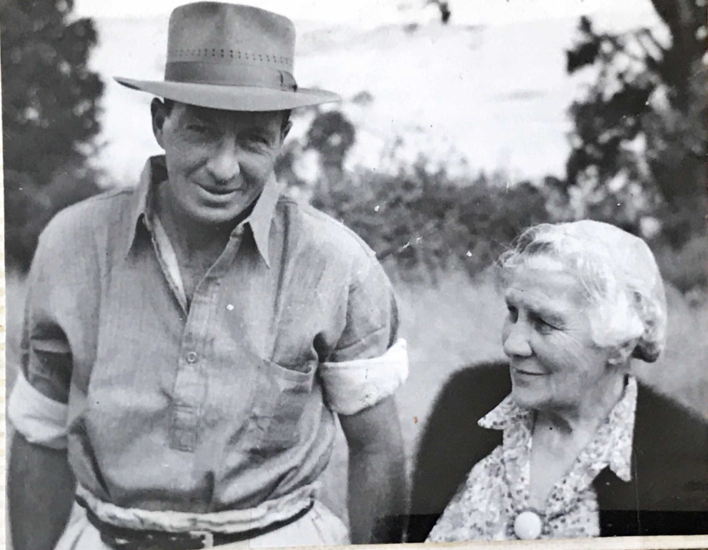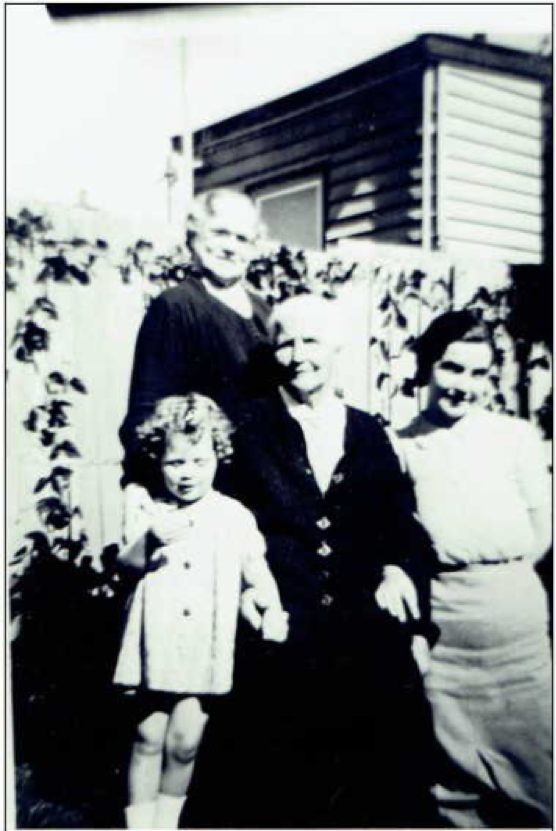Is Andrew Hassan Gardiner Designing His Ancestry to Suit the Times?
Andrew Gardiner is a well respected Elder within the modern Wurundjeri and Woi-wurrung Aboriginal clans. Interestingly, he converted to Islam in 1995, when he was about 35 years old.
Today he identifies variously as Uncle Andrew Gardiner, or Andrew Hassan Gardiner, or simply as an Aboriginal Muslim Australian, according to the audience in which he finds himself (Figures 1,2 & 3).
Figure 1 - Andrew Gardiner’s University of Melbourne profile. Source
Figure 2 - Aboriginal Uncle, Andrew Hassan Gardiner, at a Melbourne Treaty event on the steps of Parliament House in Victoria. Source : Photo Greens MP Ellen Sandell.
Figure 3 - Muslim Andrew Hassan Gardiner with his second wife. Source
Andrew Gardiner claims he is Aboriginal via his part-Aboriginal mother’s ancestry. As far as we are aware he has never(?) discussed publicly his father’s ancestry. Although he has spoken fondly and respectfully of his father [see here from 02:40], Andrew remains publicly silent regarding his paternal ancestry.
Why is that? - Is his Father’s ancestry `problematic’?
Andrew Gardiner’s Invisible Dad?
On 9 May 1922, a newly built ship, the Largs Bay, left the port of London carrying British passengers, immigrants bound for a new life in Australia.
Figure 4 - Source
The ship was owned by the Commonwealth of Australia and on board was a 30 year old farm worker, John Gardiner. As a demobilised Scottish soldier, he was taking full advantage of the goodwill offered by Australia to the survivors of the fighting in WWI. (Figure 5, last line entry)
Figure 5 - British Immigrant, John Gardiner passenger embarkation details (last line entry). Source: Ancestry.com Ship passenger records
Yet some seventy years after John Gardiner’s disembarkation in Melbourne, his grandson would appear to have decided to shun his grandfather’s, and thus his own father’s, heritage. Nowhere, as far as we have been able to determine, has Andrew Hassan Gardiner admitted that he himself is essentially of 50% Scottish (and Irish) ancestry.
Instead he has publicly chosen to solely identify as an Aboriginal man. Many might think this is very sad, and indeed disrespectful to the memory of his father, his invisible dad.
Similarly, he also appears to have failed to acknowledge his grandmother’s Northern Ireland ancestry. Nowhere could we find Andrew mentioning Catherine ‘Beryl’ Murray as being his grandmother.
Yet the publicly available genealogical records are quite clear on Andrew Hassan Gardiner’s paternal ancestry - he is a British man through and through on his father’s side (Figure 6).
Figure 6 - Alleged Paternal Family Tree for so-called Aboriginal Muslim man, Andrew Hassan Gardiner. Detailed pdf here (Subject to the Disclaimer in Note 1 below).
Several photographs, said to be of Andrew’s grandfather John Gardiner, have come to light. These are WWI photographic postcards showing his membership of the Argyll & Sutherland Highlanders (written as A & S Highlanders on the postcard).
Figure 7 - Expansion of the far-right Highlander in the group depicted in Figure 8, clearly showing the distinctive A&S Cap. This soldier is said to be John Gardiner. Source: Ancestry user Kenneth MacKenzie originally shared this on 7 Aug 2023
Figure 8 - A group of Argyll & Sutherland Highlanders in WWI including John Gardiner (said to be standing far right.) Source: Ancestry user Kenneth MacKenzie originally shared this on 7 Aug 2023
Figure 9 - Rear of postcard photograph depicted in Figure 8. Source: Ancestry user Kenneth MacKenzie originally shared this on 7 Aug 2023
Some members of the Gardiner family continue to proudly share online the military legacy of their ancestor, John Gardiner - his photograph (Figure 10) and a photograph of his military souvenirs (Figure 11).
Figure 10 - Said to be John Gardiner (centre). Source: Ancestry user Kenneth MacKenzie originally shared this on 30 Apr 2023
Figure 11 - Said to be a memorabilia frame of John Gardiner’s military items. Source: Ancestry user Kenneth MacKenzie originally shared this on 30 Apr 2023
But why is Andrew Hassan Gardiner apparently very quiet about his ancestor John Gardiner, seen here in later life in Australia in Figure 12?
Figure 12 - Said to be John Gardiner (right) in later life in Australia (he died in 1950). Source: Ancestry.com undated
One can only speculate, but owning up to being a descendant of an Argyll & Sutherland Highlander would probably be very ‘problematic’ for an Australian Aboriginal man who has converted to Islam.
For, just two months after the 1967 Aboriginal referendum in Australia, John Gardiner’s old military unit, the 1st Argyll and Sutherland Highlanders, was involved in a controversial military action, deep inside Yemen, an Islamic country.
In July 1967, the 1st Argyll and Sutherland Highlanders entered a district in Aden known as the Crater under the command of Lt. Col. Colin Campbell Mitchell [‘Mad Mitch’]. They managed to secure and occupy the entire district overnight with no casualties. This brief humiliating reversal to the Islamic Yemeni Independence movement has grated Muslim political activists ever since (Figure 13).
Mad Mitch’s reference to the Yemeni’s as ‘a lot of sort of third-rate flyblown chaps’ certainly fired up an anti-British sentiment (See Video clip below).
Figure 13 - Excerpt from an anti-Mad Mitch article by Fatimah Johnson, a citizen journalist based in the United Kingdom. By delicious irony, her final sentence, ‘He [Mitchell] resigned in 1968 and died in 1996 to join the ghosts of the South Yemenis he killed. Mitchell should have known what Shakespeare’s doomed triumvir; Mark Antony knew so well: “Kingdoms are clay”’ would come back to haunt her as Yemen itself proved to be just another ‘kingdom of clay’, destroyed by civil war.
Source: اقرأ المزيد: https://south24.net/news/news.php?nid=2411
So perhaps it was understandable when Andrew Hassan Gardiner, the Aboriginal Muslim man, quickly skipped over any reference to his paternal ancestry when he appeared on the Arabic Safi Brothers podcast [watch at 00:50].
It must be difficult for Gardiner to admonish the Victorian colonial settlers with charges of massacring Aboriginal people while knowing that his own grandfather had been a member of a British military corps that went on to kill some 382 Yemeni rebel forces and wounded a further 1,714 during the Aden Emergency (Wikipedia).
Nevertheless, by the end of 1967 the British had withdrawn from Aden, the Federation of South Arabia ceased to exist, and the People's Republic of Southern Yemen was proclaimed. Without the guardrails of British colonial institutions, Yemen came under a violent, medieval, Islamic culture and administration and thus turned into the ‘failed state shit-hole’ we see today, tragically torn apart by civil war.
Further Reading
The following photographs are said to be of Andrew Hassan Gardiner’s paternal grandmother Catherine ‘Beryl’ Gardiner (nee Murray) [1891-1992]. Her ancestry is Northern Irish (via her mother Letitia), although she was illegitimate so her father’s ancestry is unknown.
Andrew Gardiner has never, as far as we are aware, acknowledged this paternal Irish ancestry. (Figures 14 series)
Figures 14 series - Photographs of Catherine ‘Beryl’ Gardiner (nee Murray) [1891-1992]. Source: Ancestry.com
2. The following photographs are said to be of Andrew Hassan Gardiner’s paternal great-grandmother, Letitia Murray [1873-1963]. (Figures 15 series).
Figure 15 Series - Letitia Murray [1873-1963] in 1920 plowing (Figures 15 series). Source: Ancestry.com
Said to be 1938
Said to be 1938 - Letitia far left
Said to be 1922
Said to be 1938 - Letitia rear
3. Andrew Hassan Gardiner’s 2x Great-grandfather was Patrick Murray, a County Derry Northern Irishman [1830-1886]. (Figure 16). He was a one-time gold miner quite willing to, and suitably qualified for, signing a lease over Her Majesty’s Crown Land in Mudgegonga (Beechworth) Victoria (Figures 17)
Figure 16 - Said to be a photograph of Patrick Murray
Figures 17A
Figure 17B - Source
4. Said to be a photograph of Andrew Hassan Gardiner’s 2x Great-grandmother was Elizabeth McMullin, a Northern Irishwoman [1836-1882]. (Figure 16).
Notes
Note 1 : Genealogical research is not an exact science. Existing records can contain errors and new records may come to light in the future that completely change previous understandings. For these reasons, all the genealogical research and alleged Family Trees referred to here and on the Dark Emu Exposed website are subject to the following Disclaimer: All genealogical work has been undertaken in good faith by professional genealogists and archival researchers and is based on publicly available records at the time of the research. It should be noted that with all genealogical research, family trees can change if new evidence comes to light. Similarly, this research cannot account for events which may have resulted in Aboriginal ancestry entering into the family line such as via a private or unrecorded adoption of an Aboriginal child into the family, or a relationship out of wedlock between a family member and an Aboriginal person that produced a child of Aboriginal descent who was then incorporated into the family without record, or with a record that did not disclose the Aboriginality of that child.
































